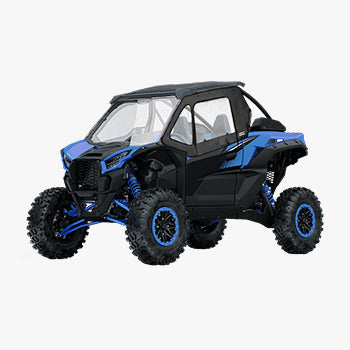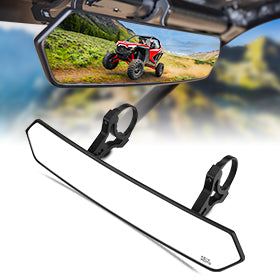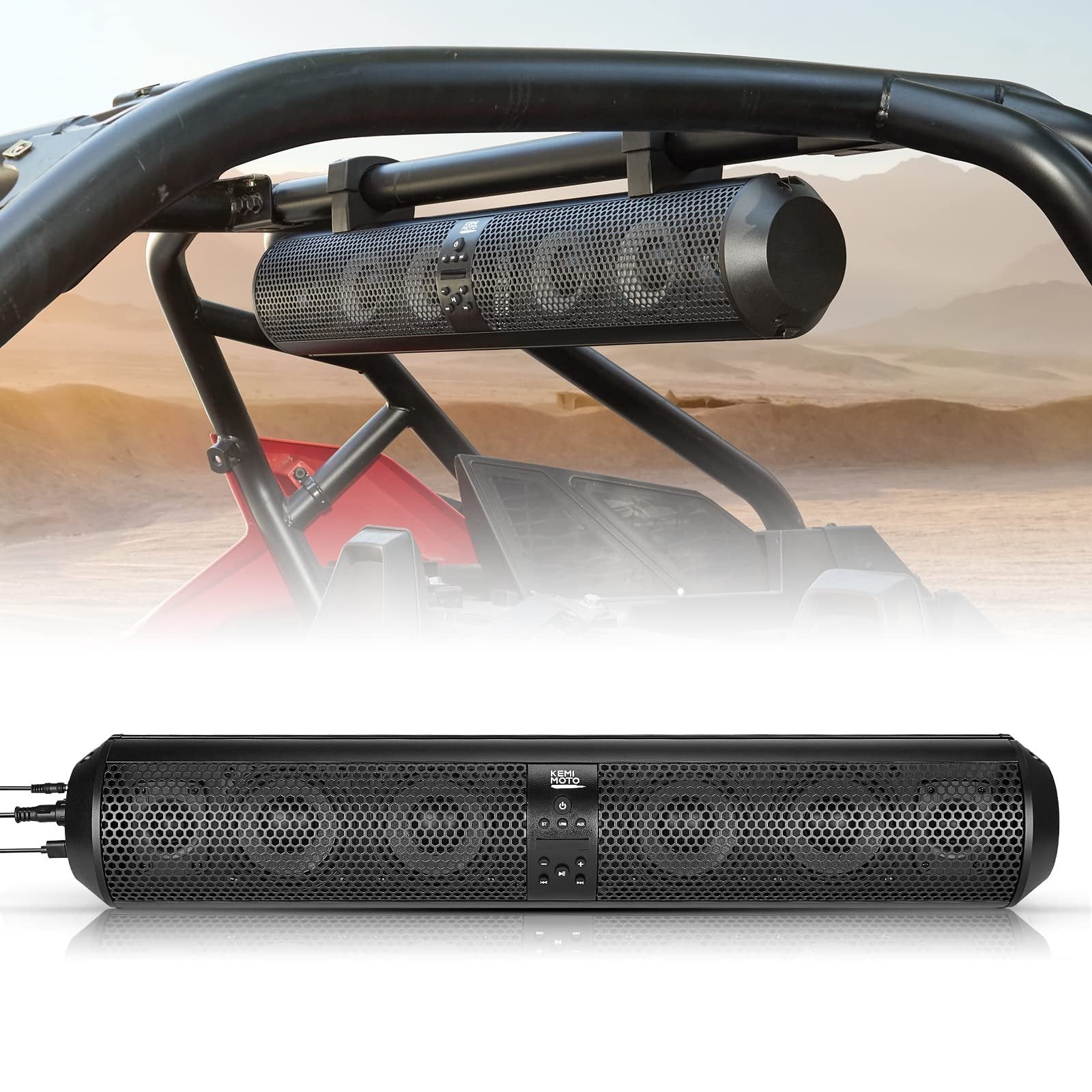Yamaha Viking vs. Polaris Ranger, Which Is Better?

Choosing between the Yamaha Viking and the Polaris Ranger can be challenging for you whether you use your UTV for off-roading, farm work, hunting, or recreational riders.
In this Yamaha Viking and the Polaris Ranger comparison blog, we will highlight their key differences in terms of features, performance, comfort, and value and help you determine which vehicle best meets your needs.
Without any further ado, let’s dive into the blog!
- Yamaha Viking vs. Polaris Ranger Comparison
- Typical Features of Yamaha Viking and Polaris Ranger
- Pros and Cons of Yamaha Viking
- Pros and Cons of Polaris Ranger
- Conclusion
- FAQs
Yamaha Viking vs. Polaris Ranger Comparison

1. Engine
The Yamaha Viking's 686cc liquid-cooled SOHC 4-stroke engine pushes 44 horsepower. The Viking provides more than enough speed and power as a work UTV.
In contrast, the Polaris Ranger's robust 999cc liquid-cooled DOHC 4-stroke engine boasts 82 horsepower, offering excellent power advantages—significant when you’re confronting steep hills or hauling heavy loads.
2. Gas Tank
The Yamaha Viking's gas tank holds 9.7 gallons, boasting an average fuel economy of around 20 mpg, whereas the Ranger, with its larger 11.35-gallon tank, has a slightly lower fuel economy of about 18 mpg.
The Ranger can operate for longer periods between refueling, a benefit during intensive use. It allows those who work long hours on their ranch without frequent refueling stops, which is particularly crucial during harvest season.
However, the Ranger does consume more fuel.
3. Transmission
When it comes to transmissions, the Yamaha Viking boasts a reliable Ultramatic V-belt with all-wheel engine braking, renowned for its durability and ease of use. It's designed for smooth and consistent power delivery, with an on-command three-way locking differential that shines in varied terrains.
The three-way locking differential is especially useful for farm work when switching tasks between flat fields and uneven terrain.
On the flip side, the Polaris Ranger features a Pro-PVT transmission known for its efficiency and advanced digital controls. The Ranger setup offers a slip-sensing all-wheel drive(AWD) system, which prevents you from getting stuck on rough terrain.
4. Power Steering
Both Yamaha Viking and Polaris Ranger have an electric power steering (EPS) system. This nifty feature gives you a helping hand in steering through those rough patches with ease, keeping the white-knuckle driving to a minimum.
However, the Polaris Ranger's system provides slightly more refined adjustability, affording a bit more precision and comfort over long periods of use.
5. Towing Capacity
Whether you want to use a UTV for work or recreational use, the towing capacity is important to factor in.
The Yamaha Viking EPS can tow up to 1,500 lbs. While the Polaris Ranger, such as the Ranger XP 1000, can tow up to 2,500 lbs.
The Yamaha Viking can well support everyday tasks and can handle heavy loads. In contrast, the Polaris Ranger, with its stronger engine and bigger fuel capacity, offers more muscle for those who frequently need to haul and tow heavier items.
Overall, these two UTVs let you lug sorts of gear like work equipment or camping supplies without breaking a sweat.
6. Size
The Polaris Ranger 1000 and the Yamaha Viking both have seating for three people and are quite comparable in overall size.
The Ranger measures 120 x 62.5 x 77 inches with an 81-inch wheelbase, whereas the Viking measures a bit larger at 122 x 61.8 x 75.8 inches and has an 84.1-inch wheelbase.
The Viking's greater size and longer wheelbase contribute to better stability and more room inside for both passengers and cargo.
On the other hand, the slightly higher stature of the Polaris Ranger offers improved ground clearance and better sightlines when navigating rough terrain.
If you’re planning to utilize your UTV primarily for work, the Yamaha Viking is slimmer and tailored with work usage in mind.

7. Custom Options
Both Yamaha Viking and Polaris Ranger can be customized or equipped with some accessories for farm work, hunting, recreational use, etc.
The Polaris Ranger has more custom options than the Yamaha Viking. Here are some of the popular Polaris Ranger accessories you can customize and upgrade the Ranger:
- Winches
- Speakers
- Windshields
- Cab heaters
- Customized Headlights
- Snow Plow attachments
- Interior Headlights
- Rear panels and storage, etc.
The Yamaha Viking also offers some customization. Some Yamaha Viking accessories you can add include:
- Doors
- Roofs
- Lights
- Winches
- Windshields
- Audio systems
- Sealed rear windows, etc.
8. Tires and Ground Clearance
With 25-inch Maxxis tires and a ground clearance of 11.8 inches, the Yamaha Viking can handle most terrains effectively.
The Polaris Ranger’s 26-inch PXT tires on aluminum wheels and superior ground clearance of 13 inches give it an edge in rugged terrain, providing better traction, obstacle navigation, and comfort.
Whether you're crossing streams or climbing over logs, you can trust these tires to keep you moving forward.
But when you’re traversing a rocky trail, the extra 1.2 inches of ground clearance provided by the Polaris Ranger can mean the difference between gliding over obstacles or getting stuck.
9. Storage
Both the Yamaha Viking and Polaris Ranger have spacious interiors for up to three people and generous storage options for packing essentials.
The Viking's cargo bed holds 600 lbs compared to the Ranger's larger 1000 lbs capacity, making the Ranger more suitable for tasks like search and rescue where extra equipment and space are essential.
Each UTV includes a glove box, cup holders, and under-seat storage, but the Polaris Ranger also offers Lock & Ride Storage for additional gear. With a total storage volume of 9.7 gallons, the Yamaha Viking falls short of the Ranger's 19 gallons.
However, keep in mind that the Ranger can not make a turn very well when carrying a full 1000 lbs.
10. Top Speed
The Yamaha Viking has a top speed of about 50 mph, while the top speed of the Polaris Ranger can reach up to about 60 mph thanks to the more powerful engine and transmission.
On your large property, you will appreciate the Polaris Ranger for it can quickly move between distant points, saving time during your workday.
11. Brakes
The Yamaha Viking includes reliable four-wheel hydraulic disc brakes, ensuring consistent stopping power for demanding off-road conditions. These brakes are built for durability and easy maintenance, suitable for the Viking's utility-focused design.
In contrast, the Polaris Ranger also comes with four-wheel hydraulic discs but ups the ante with an optional Anti-lock Braking System (ABS). This technology prevents wheel lock-up during abrupt braking, allowing for better control on slick or uneven terrain. The Ranger's ABS gives it an extra edge in safety and handling precision.
12. Warranty
A longer 12-month factory warranty on the Polaris Ranger provides additional peace of mind compared to the 6-month warranty on the Yamaha Viking.
The Polaris Ranger's Factory Warranty provides cover for parts with material or workmanship defects, including the repair or replacement of these parts as well as the associated labor costs.
13. Price
The Yamaha Viking starts at an MSRP of $11,999 (Viking EPS model), providing reliable performance at a more affordable price.
In contrast, the Polaris Ranger starts at $13,999 (Ranger XP 1000 model), offering more power and features with an extended warranty to justify the higher price.

Typical Features of Yamaha Viking and Polaris Ranger
Yamaha Viking Features
Let’s take a look at some of the most popular features of the Yamaha Viking:
- 686cc liquid-cooled SOHC 4-stroke engine with 44 horsepower
- On-command 3-way locking differential for 2WD, 4WD, and full differential lock modes with automatic transmission
- EPS System for responsive, smooth handling
- Towing capacity of up to 1500 lbs
- Approximately 20 mpg fuel efficiency
- Durable 25-inch Maxxis tires for versatile traction
Polaris Ranger Features
Here are a few of the most popular Polaris Ranger features:
- 999cc liquid-cooled DOHC 4-stroke engine
- Automatic PVT transmission with ABS for enhanced driving stability
- Enhanced EPS System for precision control
- True On-Demand AWD/2WD/VersaTrac Turf Mode for different terrain
- Towing capacity of up to 2500 lbs
- Extensive optional accessories
- 13-inch ground clearance for superior off-road capability
- Cargo box capable of handling up to 1,000 lbs
- In-cab storage space totaling 19 gallons
- Capable of reaching top speeds around 60 mph
Pros and Cons of Yamaha Viking
Pros:
- On-command differential lock
- Reliable and durable engine and transmission
- Provides good performance and is pretty friendly for beginners
- Slimmer for farm working
Cons:
- The engine is less powerful than the Polaris Ranger 1000
- Towing capacity and bed weight might not be enough
- Only 6-month Limited Factory Warranty
- Half doors might let in dust and mud on muddy trails
Pros and Cons of Polaris Ranger
Pros:
- More powerful engine than the Viking in the 1000 class
- More cargo capacity and in-cab storage than the Viking
- Smooth ride and spacious cab
- Higher towing capacity of 2500 lbs
- Includes 12-month Limited Factory Warranty
- Extensive range of accessories and custom options
- Affordable quality UTV
Cons:
- Slightly wider than some UTVs
- Handling characteristics might be a concern for beginners
Conclusion

So, the Yamaha Viking and the Polaris Ranger are both excellent UTVs for working and recreational uses and both of them have their pros and cons.
The Yamaha Viking is ideal for those who prioritize reliability, durability, fuel efficiency, and versatility. On the other hand, the Polaris Ranger appeals to those who value sheer power and extensive customization options.
The best way to determine which one is better for you is to take them for a test drive. Regardless of which one you eventually prefer, remember that you can always find Polaris Ranger accessories and Yamaha Viking accessories at Kemimoto.com to enhance your UTV's performance and ensure you take on the trails with confidence!
FAQs
1. Is the Yamaha Viking Any Good?
The Yamaha Viking is a very good UTV that offers great power, comfort, roominess, and reliability.
It also has an On-Command system that lets you switch between different drive modes. The Yamaha Viking is a versatile, reliable, and durable machine that can handle any outdoor task.
2. Can a Yamaha Viking Be Street-Legal?
A Yamaha Viking can be street-legal if it meets the requirements of the state where it is registered. Some of the common requirements are headlights, taillights, turn signals, mirrors, horns, windshields, license plates, and insurance.
However, the laws may vary from state to state, so you’d better check your local DMV before driving your Yamaha Viking on public roads.
3. Where Is Yamaha Viking Manufactured?
The Yamaha Viking is manufactured in Newnan, Georgia. Yamaha has a 1.3 million square foot facility there that produces UTVs, ATVs, golf carts, and watercraft.









Dejar un comentario